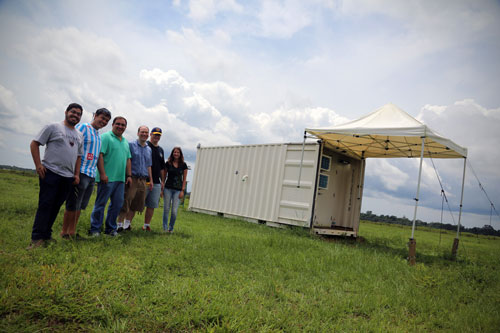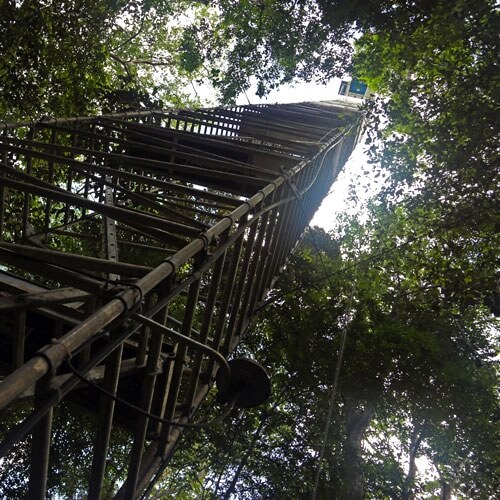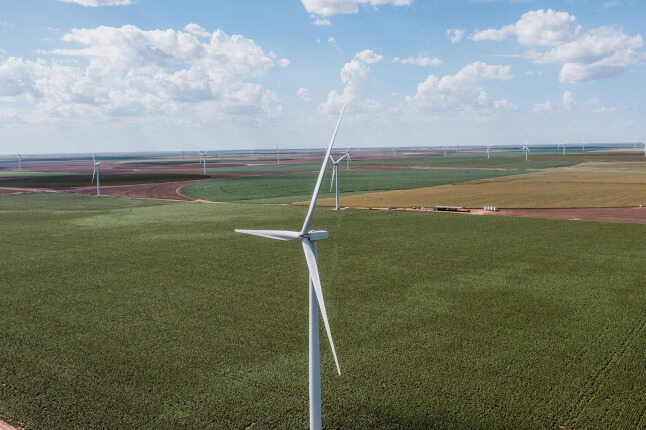News
A ladder to the top of the rainforest. (Photo by Ned Brown/Harvard Gazette.)

The lab. (Photo by Ned Brown/Harvard Gazette.)
MANAUS, Brazil — Walking along a path in the Amazon rainforest, several overheated travelers come across a copper-colored brook rippling under a mossy wooden bridge. It’s an inviting sight. But the beckoning waters could well camouflage a deadly predator.
“The huge snake the anaconda loves to stay in these small rivers,” said Bruno Takeshi, a tall, unflappable Brazilian, referring to the massive reptile that squeezes the life out of its prey.
On this steamy afternoon in early August, Takeshi, who studies how changes in soil relate to climate science, and his collaborators, Harvard Professor Scot Martin and Martin’s Ph.D. student Suzane Simões de Sá, don’t linger by the river. Instead, they continue their twisting trek through the thick forest ringing with the songs of unseen insects and birds, until they reach their incongruous goal, a 177-foot aluminum tower.
The tower is used in climate research, and resembles a number of such structures that will soon be part of a massive, coordinated campaign to track something that, over decades, could prove more deadly than the Amazon’s anacondas, something that floats invisibly, high above the pristine jungle: air pollution.
The research project is called GreenOceanAmazon2014 (GoAmazon2014), a collaboration among the U.S. Department of Energy and several Brazilian and other international partners. The program, for which Takeshi is project manager, studies the environmental impact of a growing pollution plume generated in Manaus, Brazil, a burgeoning industrial center carved from the dense forest.
A busy city near an unbroken forest
Researchers hope to ascertain how the city’s smog is affecting some of the cleanest air in the world, changing cloud formation and rainfall in the region, and influencing global climate change. For scientists, the busy city encircled by miles of unbroken forest is a perfect natural laboratory, a kind of controlled experiment.
“Manaus is a great test bed. It’s an isolated urban region with 2,000 kilometers of forest around it,” said Martin, Harvard’s Gordon McKay Professor of Environmental Chemistry, the principal investigator for the project. In “most places, there are so many possible pollution sources, it’s very difficult to dissect and interpret the data. Here, it’s a much more straightforward experiment, given there’s only one major pollution source.”
On the hike to the tower, Martin pauses occasionally to wipe steam from his wire-rimmed glasses. In his checked shirt, khaki shorts, black sneakers, and bright yellow Brazilian national soccer team cap, he looks less like a jungle explorer than a casual tourist who took a wrong turn in the woods. But he is as comfortable and confident in this rugged environment as any whip-wielding Indiana Jones.
Climbing the tower as it sways with the wind is not for the faint of heart. Slim aluminum scaffolding connects a series of equally thin platforms and ladders. For the first-time climber, the ground disappears at an alarming rate during the ascent as the green leaves of hundreds of species of trees quickly swallow the brown forest floor. Higher up, the incessant buzz of the jungle is replaced by a calm silence, the heat eased by a steady breeze. At the top, above the tree canopy, the view is of a “green ocean,” an endless expanse of emerald in every direction.
Read the entire article in the Harvard Gazette
Researching how pollution affects climate change in the Amazon
Professor Scot Martin is studying how pollution affects rainfall and climate change in the Amazon basin near Manaus, Brazil, as part of an international campaign coordinated with the U.S. Department of Energy called GoAmazon 2014.
Topics: Environment, Climate
Cutting-edge science delivered direct to your inbox.
Join the Harvard SEAS mailing list.
Scientist Profiles
Scot T. Martin
Gordon McKay Professor of Environmental Science and Engineering and Professor of Earth and Planetary Sciences



